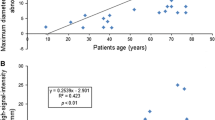Abstract
Purpose
The advancement of magnetic resonance (MR) imaging technology has revealed that intracranial venous anomalies, such as vertical embryonic positioning of the straight sinus (VEP of SS), are associated with atretic parietal cephaloceles. However, the precise anatomical relationships among the venous anomalies, superior sagittal sinus (SSS), cistern, and cephalocele have not been demonstrated. We compared the imaging features of conventional MR images and high-resolution 3-dimensional (3-D) MR images, such as Fourier-transformation-constructive interference in steady-state (CISS) images and T2-weighted reversed (T2R) images obtained on a 3-T MR machine.
Methods
Three patients ranging in age from 1 to 18 years, with midline subscalp lesions, participated in this study. In two cases, the lesions were surgically excised and subjected to pathological examination.
Results
In two children, 3-D MR images more clearly demonstrated anomalous veins, including bilateral internal cerebral veins, the great vein of Galen and the vertical position of the straight sinus in the falx, extending superiorly within the CSF tract in the posterior interhemispheric fissure. While the vertical straight sinus drained into the SSS, the CSF tract maintained a position posterior to the anomalous veins, ran through the SSS and extended to the skull defect. In one patient, ascending positioning of the anomalous vein from the inferior sagittal sinus to the SSS in the CSF space was observed; this could not be depicted on conventional MR images.
Conclusion
Detailed findings of the venous anomalies on 3-D MR images provide clues to the diagnosis of atretic cephalocele.



Similar content being viewed by others
References
Bale PM, Hughes L, De Silva M (1990) Sequestrated meningoceles of the scalp: extracranial meningeal heterotopia. Hum Pathol 21:1156–1163
Brunelle F, Baraton J, Renier D, Teillac D, Simon I, Sonigo P, Hertz-Pannier L, Emond S, Boddaert N, Chigot V, Lellouch-Tubiana A (2000) Intracranial venous anomalies associated with atretic cephaloceles. Pediatr Radiol 30:743–747
Curnes JT, Oakes J (1988) Parietal cephaloceles: radiographic and magnetic resonance imaging evaluation. Pediatr Neurosci 14:71–76
Drapkin AJ (1990) Rudimentary cephalocele or neural crest remnant? Neurosurgery 26:667–673
Fujii Y, Nakayama N, Nakada T (1998) High-resolution T2-reversed magnetic resonance imaging on a high magnetic field system. Technical note. J Neurosurg 89:492–495
Gulati K, Phadke RV, Kumar R, Gupta RK (2000) Atretic cephalocele: contribution of magnetic resonance imaging in preoperative diagnosis. Pediatr Neurosurg 33:208–210
Güzel A, Tatli M, Er U, Bavbek M (2007) Atretic parietal cephalocele. Pediatric Neurosurg 43:72–73
Hashiguchi K, Morioka T, Fukui K, Miyagi Y, Mihara F, Yoshiura T, Nagata S, Sasaki T (2005) Usefulness of constructive interference in steady-state (CISS) MR imaging in the presurgical examination for lumbosacral lipoma. J Neurosurg (6 Pediatrics) 103:537–543
Hashiguchi K, Morioka T, Yoshida F, Miyagi Y, Mihara F, Yoshiura T, Nagata S, Sasaki T (2007) Feasibility and limitation of constructive interference in steady-state (CISS) MR imaging in neonates with lumbosacral myeloschisis. Neuroradiology 49:579–585
Inoue Y, Hakuba A, Fujitani K, Fukuda T, Nemoto Y, Umekawa T, Kobayashi Y, Kitano H, Onoyama Y (1983) Occult cranium bifidum. Radiological and surgical findings. Neuroradiology 25:217–223
Marrogi AJ, Swanson PE, Kyriakos M, Wick MR (1991) Rudimentary meningocele of the skin. J Cutan Pathol 18:178–188
Martinez-Lage JF, Sola J, Casas C, Poza M, Almagro MJ, Girona DG (1992) Atretic cephalocele: the tip of the iceberg. J Neurosurg 77:230–235
McLaurin RL (1964) Parietal cephaloceles. Neurology 14:764–772
McLone DG, De Leon G (1998) Atretic encephalocele. Pediatric Neurosurg 28:326
Morioka T, Hashiguchi K, Yoshida F, Nagata S, Miyagi Y, Mihara F, Sasaki T (2007) Dynamic morphological changes in lumbosacral lipoma during the first months of life revealed by constructive interference in steady-state (CISS) MR imaging. Child’s Nerv Syst 23:415–420
Morioka T, Hashiguchi K, Yoshida F, Matsumoto K, Miyagi Y, Nagata S, Yoshiura T, Masumoto K, Taguchi T, Sasaki T (2008) Neurosurgical management of occult spinal dysraphism associated with OEIS complex. Child’s Nerv Syst 24:723–729
Naidich TP, Altman NR, Braffman BH, McLone DG, Zimmerman RA (1992) Cephaloceles and related malformations. AJNR Am J Neuroradiol 13:655–690
Nakada T (2007) Clinical application of high and ultra high-field MRI. Brain Dev 29:325–335
Otsubo Y, Sato H, Sato N, Ito H (1999) Cephaloceles and abnormal venous drainage. Child’s Nerv Syst 15:329–332
Padget DH (1956) The cranial venous system in man in reference to development, adult configuration, and relation to the arteries. Am J Anat 98:307–355
Patterson RJ, Egelhoff JC, Crone KR, Ball WS Jr (1998) Atretic parietal cephaloceles revisited: An enlarging clinical and imaging spectrum? AJNR Am J Neuroradiol 19:791–795
Tubbs RS, Doughty K, Smyth MD, Oakes WJ (2004) Parietal cephalocele. Pediatr Neurosurg 40:37–38
Yamazaki T, Enomoto T, Iguchi M, Nose T (2001) Atretic cephalocele. Report of two cases with special reference to embryology. Child’s Nerv Syst 17:674–678
Yokota A, Kajiwara H, Kohchi M, Fuwa I, Wada H (1988) Parietal cephalocele: clinical importance of its atretic form and associated malformations. J Neurosurg 69:545–551
Acknowledgment
We thank Mikiko Hidaka for administrative support.
Author information
Authors and Affiliations
Corresponding author
Rights and permissions
About this article
Cite this article
Morioka, T., Hashiguchi, K., Samura, K. et al. Detailed anatomy of intracranial venous anomalies associated with atretic parietal cephaloceles revealed by high-resolution 3D-CISS and high-field T2-weighted reversed MR images. Childs Nerv Syst 25, 309–315 (2009). https://doi.org/10.1007/s00381-008-0721-6
Received:
Revised:
Published:
Issue Date:
DOI: https://doi.org/10.1007/s00381-008-0721-6




